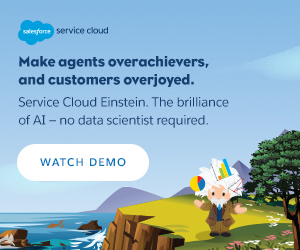This content was produced for Salesforce by the foundry @ MEREDITH CORP. FORTUNETM editorial staff was not involved in its creation or production.
Digital transformation has made it possible for today’s enterprises to harvest rich, detailed, plentiful data. But it means nothing if it doesn’t accomplish its most important goal: to continuously improve the customer experience and fine-tune personalization efforts across platforms.
 Photo: Getty Images
Photo: Getty Images
In the age of the customer, anything less than exceptional customer service won’t cut it. Not when disruptors are nipping at your heels. The fact is, then, that data is only useful if it can make your company deft, creative, and sharply attuned to customer sentiment and demand. And to meet and satisfy this demand, service agents must learn to adapt on the fly. That’s where digital agility at scale comes into play.
Scale to Prevail
At the outset, digital agility was all about moving to the cloud and taking advantage of Software as a Service (SaaS). That initial technological phase and the lean approaches it engendered made it easy to react when demand fluctuated.
But today, leading firms have been quick to grasp that there is no agility if they can’t meet customer demands at scale. They also recognize that doing so calls for a cloud investment that’s ready to scale as needed. This means having precision tools that can react swiftly and effortlessly to every customer expectation and channel, including those that have yet to emerge.
Go Right or Go Home
Remember the expression “go big or go home”? That concept is so 20th century. In today’s business environment, digitally agile companies recognize that just the opposite is true. They understand that it doesn’t always make sense to onboard more people or make major capital investments when business suddenly picks up.
Instead, they take a tactical approach. They use the data they’ve collected from customers through various channels and technologies to plan strategically. They leverage tools such as artificial intelligence (AI) to help them plot their attacks and determine how to grow without blowing the budget. Salesforce Einstein, for example, helps put decision-making in the hands of customers by giving sales reps, marketers, and analysts the assessments they need to connect with clientele. And no one has to do the math or run algorithms. Modeling is built right in to such products.
With digital agility at scale, more isn’t necessarily better. It’s about addressing new opportunities without putting undue stress on your current resources. The good news is that every company can now meet the challenge of becoming agile at scale, because the latest phase of technology can:
Help you stay one step firmly ahead of customer, agent, and business needs with ever-improving AI.
Harness uncertainty so your firm can embrace rapid change, wherever the future takes you.
Empower people on the front lines to make changes, because your customers, and the staff that serve them, are your biggest resource.
Help small teams address discrete problems by empowering them to focus less on what’s wrong and more on what if ?
Encourage continuous improvement by gleaning insights from existing channels to shape how you operate and innovate.
Becoming a digital enterprise at scale is the key to surviving relentless disruption. A study by Harvard Business School shows that agile companies leap ahead of their competitors. It also reports that such enterprises have customer experience woven into their DNA. These companies bring new products to market faster and find novel ways to cut costs.
Research further reveals that scaling up properly delivers real bottom-line results. The reason: Innovation drives decision-making, replacing business-as-usual mentalities. Digital agility at scale alerts firms to subtle and dramatic customer demands in sufficient time to respond and benefit from them. Priorities become flexible, crises become opportunities, and the freedom to fail points the way to success. In short, disruption becomes the new normal.
Scaling can also change the very culture of an enterprise—making it reconsider its principles, values, and purpose from the perspective of agility. Improved efficiency and productivity may not be the primary motive behind scaling, but they’re often a welcome side effect.
The takeaway: You need to be firmly and relentlessly customer facing if you want to survive. That’s the true definition of digital agility, and it means making use of every technique at your disposal to accomplish that goal. Keep in mind, though, that all the information in the world won’t help you if you don’t use it to treat your customers to a complete and effortless experience. The right tools can make that happen. Are you using them?







